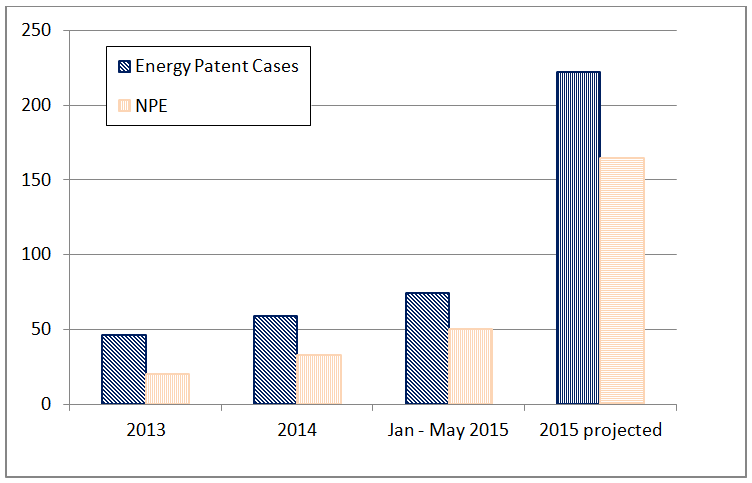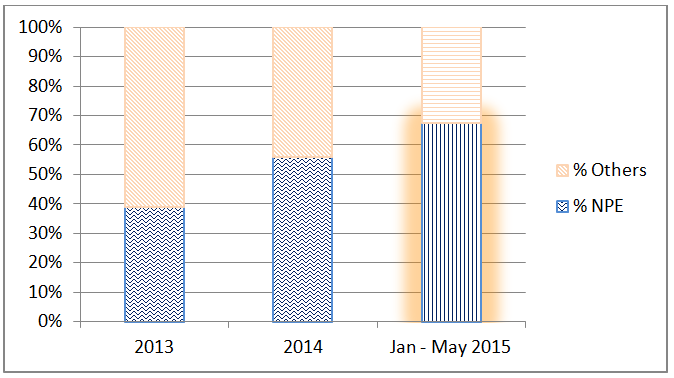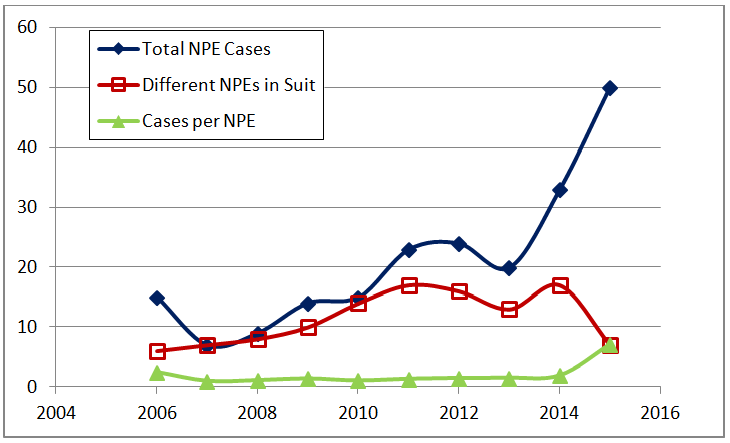New data shows a sharp increase in the number of patent troll lawsuits being filed against energy companies in 2015.
As we predicted over the past year, we have seen a continued increase in both the percentage and number of so-called “patent troll” lawsuits being filed against energy companies.
Last year, we conducted a survey to analyze the number of patent lawsuits filed against energy companies between 2006 and 2013.1 The focus was to uncover any industry-specific trends in lawsuits filed by patent trolls. We observed that, in general, the percentage of lawsuits brought by patent trolls was increasing over time. As we noted in our previous survey, complaints about patent trolls—also known as non-practicing entities (NPEs) and patent assertion entities (PAEs), among other names—previously came primarily from technology and retail companies, which had been embroiled in litigation against patent trolls. In the spring of 2014, we predicted that there would be more cases filed by NPEs (which we defined as entities, other than universities, that do not manufacture anything and do not provide any services) against energy companies in the coming years, and that at least 30% of all patent cases against the energy industry would be filed by NPEs.
After updating our survey with new data from 2014 and the first five months of 2015,2 we observed that the total number of energy patent cases filed in 2014 did not show a dramatic increase over 2013, yielding a total of 59 cases. However, in the first five months of 2015, we saw a sharp increase in the number of patent lawsuits being filed against energy companies. Specifically, there were 74 energy patent cases filed between January 2014 and May 2015—more than the total number of cases filed in the entire preceding year (see Figure 1). If this trend continues for the rest of 2015, we may see well over 200 energy patent cases for 2015.
Figure 1 Total Energy Patent Cases by Year
The Updated Survey
Following the same methodology as last year, we obtained our source data from the LexMachina database, then manually reviewed each case where LexMachina categorized one of the defendants as an “energy” company. We then reviewed each case with an energy company defendant to confirm (based on publicly available information) that the defendant was indeed an energy company and that the plaintiff was an NPE.
The results of our updated analysis confirm that over the past year, NPEs have been increasingly targeting the energy industry. Figure 2 shows the percentage of energy patent cases brought by NPEs since 2013. Up until 2013, the percentage of NPE cases filed against energy companies had averaged less than 20% throughout the past decade. In 2013, the percentage surged above 20% for the first time to reach 39%. As expected, in 2014, the percentage of NPE cases against energy companies maintained its steady climb to 56%. Preliminary data for 2015 indicates that NPEs may be responsible for as many as 68% of all energy patent cases this year!
Figure 2 Percentage of Energy Patent Cases Brought by NPE
Interestingly, while the number of total energy patent cases filed by NPEs had seen a significant increase in the past year, the number of NPEs filing the respective cases sharply decreased in the first five months of 2015. To illustrate this point, Figure 3 plots the total number of NPE cases, the number of different NPEs filing the cases, and the average number of cases filed by each NPE.
Figure 3 Filing trend of NPEs
As can be seen from Figure 3, the average number of energy patent cases brought by NPEs remained between 1 to 2.5 cases per NPE until 2014. This historical trend was disrupted in the first five months of 2015 with a smaller group of NPEs filing more cases, resulting in an average of about seven cases per NPE. Although it is still early in the year, this trend seems to indicate that a relatively small number of NPEs will be responsible for most of the patent troll cases in the energy industry in 2015.
One contributing factor to the trend discussed above is that there is a diverse range of technologies being accused, not just technologies that are uniquely associated with the energy industry. For example, in 2014 and 2015, the accused technologies included mobile-worker location tracking, near-field communication, and call routing—technologies that are used across many industries—as well as technologies such as downhole tools and fracking operations, which are traditionally associated with the energy industry. Many of the non-energy-specific technologies being accused coincided with major technology-use trends in the energy industry (e.g., mobile location-aware technology). It is likely that patent trolls (and those financing them) are viewing the assertion of these patents in different sectors as simply the next step in their ever-expanding reach to monetize their IP assets.
Further, according to a recent informal survey published in Stanford Technology Law Review[3], it was found that among the sampled technology companies that received NPE demand letters, as high as 40% were based on their “use” of another’s technology, not the manufacturing of a patented technology. It appears that the increased use of information technology in the energy industry (e.g., big data, cloud, wireless network, mobile location-aware and predictive analytics) has therefore increased the exposure of energy companies to patent troll lawsuits.
Practical Considerations
Some steps that energy companies could take to prepare for defending against patent troll lawsuits include:
-
Monitoring legislative and other legal changes in this area, which continue to occur at a remarkable pace.
-
Consider filing an inter partes review (IPR) as a lower-cost and possibly more effective way of challenging the validity of the patents.
-
If the patents accuse industry standards of infringing, then pay close attention to whether the NPE has complied with its standard setting organization (SSO) and/or reasonable and non-discriminatory (RAND) royalty rate obligations.
-
Note that non-infringement opinions are now more important than invalidity opinions for defeating claims of induced infringement.
-
Review internal litigation budgets so as to be prepared to respond to these lawsuits, especially if competitor suits also experience an uptick.
Conclusion
Our updated survey shows that NPEs are increasingly targeting the energy industry. In fact, energy companies could see NPE cases soar to nearly 70% of all patent cases filed against them in the next few years. Energy companies should therefore be prepared for this shift in the mix of patent cases and some of the unique challenges and costs associated with NPE cases.
[1] David Levy and Nicholaus Floyd, Are Patent Trolls Now Targeting The Energy Industry?, Law360, April 4, 2014.
[2] Data was obtained from LexMachina.
[3] Colleen Chien, Startups And Patent Trolls, 17 Stan. Tech. L. Rev. 461, (2014).



 />i
/>i



